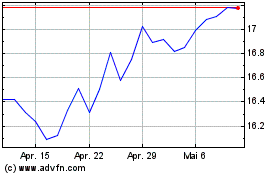AT&T Reports Drop in Wireless Phone Customers
23 Oktober 2016 - 4:53AM
Dow Jones News
By George Stahl and Thomas Gryta
AT&T Inc., in addition to announcing its $85.4 billion deal
to buy Time Warner Inc., reported its third-quarter financial
results Saturday, which provided a view into the reasons why the
company is seeking to diversify away from the U.S. wireless
business.
In the U.S., AT&T lost 268,000 mainstream wireless phone
customers. Phone additions are considered important because they
provide more service revenue than tablets, and customers with
postpaid phone accounts tend to stay longer. Including other
devices, AT&T added a total of 212,000 mainstream wireless
customers.
In all, AT&T's total wireless revenues dipped 0.7%, to $18.2
billion, which the company blamed on decreases in service and
equipment revenue.
The results came three days early as AT&T also announced on
Saturday its agreement to buy Time Warner Inc. The cash-and-stock
deal values Time Warner -- owner of CNN, TNT, HBO and the Warner
Bros. film and TV studio, among other things -- at $107.50 a share
and transforms AT&T into a media giant.
The Time Warner deal is seen helping AT&T potentially find
new areas of growth as its core wireless business has become
saturated and its share of the mobile market leaves little room for
acquisitions. In the competitive consumer wireless market, AT&T
has been focused on retaining its most profitable customers and
shying away from promotional offers to grab market share.
AT&T Chief Executive Randall Stephenson would head the new
company. The companies said Time Warner Chief Executive Jeff Bewkes
would stay for an interim period following the close of the deal to
help with the transition.
AT&T already is the biggest U.S. pay-television operator
after its $49 billion acquisition last year of DirecTV. The
company's video business lost a net 3,000 customers in the quarter
as additions in the DirecTV business failed to surpass the losses
in its older U-Verse pay television service.
AT&T has been pushing customers to the satellite service
since the DirecTV deal closed. AT&T lost almost 200,000 video
customers in that time but has said it would be net positive for
the year. It will now need to add 106,000 customers in the final
quarter of the year to meet that goal.
Over all, for the quarter ended Sept. 30, AT&T's earnings
increased to $3.33 billion, or 54 cents a share, from $2.99
billion, or 50 cents a share. Excluding certain costs -- such as
those for amortization and integration -- AT&T had per-share
earnings of 74 cents, flat from the year-ago period and in-line
with the average analyst estimate on Thomson Reuters.
Revenue rose 4.6% to $40.89 billion, below the average analyst
estimate of $41.15 billion on Thomson Reuters. The year-over-year
increase largely reflected the DirecTV acquisition. Excluding
DirecTV and foreign exchange, AT&T said revenue was essentially
flat, as growth in video and IP-based services mostly offset
pressures from declines in wireless and legacy services.
Along with its quarterly report, AT&T also raised its
quarterly dividend by 2.1%, to 49 cents from 48 cents, representing
its 33rd straight annual increase.
Write to George Stahl at george.stahl@wsj.com and Thomas Gryta
at thomas.gryta@wsj.com
(END) Dow Jones Newswires
October 22, 2016 22:38 ET (02:38 GMT)
Copyright (c) 2016 Dow Jones & Company, Inc.
AT&T (NYSE:T)
Historical Stock Chart
Von Mär 2024 bis Apr 2024

AT&T (NYSE:T)
Historical Stock Chart
Von Apr 2023 bis Apr 2024
